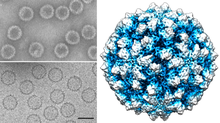| Quadrivirus | |
|---|---|
 | |
| (Left) Electron micrographs of the Rosellinia necatrix quadrivirus 1, bar = 50 nm. (Right) Three-dimensional cryo-electron microscopy reconstruction of RnQV1 virions at 8Å resolution. | |
| Virus classification | |
| (unranked): | Virus |
| Realm: | Riboviria |
| Kingdom: | Orthornavirae |
| Phylum: | Duplornaviricota |
| Class: | Chrymotiviricetes |
| Order: | Ghabrivirales |
| Family: | Quadriviridae |
| Genus: | Quadrivirus |
Quadriviridae is a family of double-stranded RNA viruses with a single genus Quadrivirus. [1] The fungi Rosellinia necatrix serves as a natural host. The name of the group derives from the quadripartite genome of its members where in Latin quad means four. The genus has three species. [2] [3]


